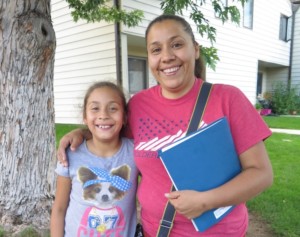Engaging Families in Distance Learning: Supporting from Afar

By: Erin Gohl and Kristen Thorson
Throughout our world, families are facing the reality that schools—a source of structure, continuity, and growth—must close for several weeks, and possibly longer, as we seek to flatten the curve of COVID-19. Our entire system, including administrators, educators, parents, and students, finds itself in uncharted territory. A major area of concern as we navigate these uncertain and evolving circumstances is how to proceed given that the locus of learning has shifted from schools to homes and the modality of instruction, for most, is transitioning from face-to-face to online. These transitions are occurring in a general context of stress and worry, and are happening simultaneously with many parents making similar shifts in their professional lives.
Research and practice have long recognized the importance of engaging families in learning. This is true now more than ever as a strong and supportive partnership between schools and families is the lynchpin upon which success for this new kind of learning rests. As families work through the challenges of making these transitions, educators must use best practices for family engagement in order to provide emotional and technical support, compassion, and encouragement as they partner on facilitating learning from the home.
Take Into Account Large Variations Among Families
As districts and schools create distance learning plans, it is essential they take into account variations among families. Solutions and resources must be flexible enough to accommodate these differences. For example, many families have children of different ages, which creates additional challenges when trying to engage in grade- or age-specific learning. If there are scheduled times for any part of your distance learning plan, consider spacing them out by grade level.
When developing family engagement plans and strategies under traditional circumstances, schools and districts must not have expectations for advanced literacy levels in the home. The same care must be taken for digital literacy skills. Schools and districts must structure directions and expectations for parents who are novice technology users. They must also expect a wide variation in access to devices and internet connectivity across many communities. Even families who are fortunate enough to have a device their kids can use either at home or from school may not have multiple devices available for their children to use simultaneously. Finally, distance learning cannot have the same expectations as classroom learning. Educators cannot presume any certain materials or prior knowledge. We must create multiple pathways for learning to meet each family’s unique circumstances, backgrounds, and experiences.
Families Need Clear, Effective, and Supportive Communication
Though schools are moving to different modalities to facilitate learning, they should continue to utilize many of their existing channels of communication in order to engage families. Tools such as Seesaw, Class Dojo, and Remind provide effective ways for schools and teachers to continue to connect with students. With the daily or weekly school pickup and dropoff routines gone and a lack of face-to-face interactions between schools and families, regular, frequent, multimodal communications will be fundamental for families to feel connected and supported.
Just as educators are in uncharted waters, most families are nervous about managing the logistics and content of their children’s education. They need messaging and interactions from educators that are supportive, positive, compassionate, and encouraging in order to effectively facilitate this learning at home. If expectations feel rigid or learning feels pressured, students and families will not be able to keep up for long. Instead, praise small steps. Remind families that learning and technology hiccups will occur, just as they do in classrooms.
Recognize the Unique Potential of At-Home Learning
Most narratives in recent days have focused on what might be lost as learning transitions to be digital- and home-based. However, educators and families alike should recognize that the home environment allows for unique opportunities for embedded, organic learning that is not always possible in the classroom. And it is important to remember that activities that spark learning need not feel like traditional homework in order to create high-quality, effective learning experiences.
Life Skills: Parents are students’ first teachers and they already do a great deal of teaching in their natural day-to-day routines and activities. Remind parents that doing chores—such as cleaning, sorting laundry, washing dishes, making beds, and other ways to contribute—are meaningful, real-world learning experiences. Families might cook or bake together or encourage their kids to take on making their own lunches. Teaching kids to do yard work or gardening are additional, valuable life skills that this extra time at home can foster.
Nontraditional Academic Learning: Educators can encourage families to engage in critical thinking activities that bolster cross-curricular skills as our children plan a dinner meal using the ingredients in our kitchens, set up a grocery store where they have to calculate cost and change as they sell their goods, or create an original board game for their family to play in the extra hours at home. Older students might research and write letters or emails to elected officials or companies advocating for a particular policy or position. And to build academic skills together, families might listen to an Audible audiobook (many selections have now been made free) or watch zoologists broadcasting from national zoos and aquariums.
Social-Emotional Learning (SEL): Homes are ripe with opportunities for SEL growth. SEL is rooted in creating and maintaining relationships and friendships through managing emotions and making responsible decisions, all of which happen regularly through family interactions. To teach SEL, use opportunities such as playing a board game, learning to patiently wait, or other experiences that happen every day. Encourage parents to notice and recognize when their children show perseverance, flexibility, independence, or generosity within their day-to-day interactions. Recognizing and praising these qualities incentivizes these kinds of positive behaviors.
Books are another platform for conversations around SEL. Many books families already have in their homes contain examples of friendship, conflict, and dialogue. These books can serve as visual models for social experiences. Talk about the characters and what is happening in the story to give your child access to the words and language used to describe different feelings.
The Arts: Encourage families to foster creative thinking by drawing pictures, writing poems, and jotting notes to friends and family. Families might also listen and dance to music to create some levity in tough moments. Further, art can be a creative outlet for all the big emotions that kids and families are experiencing at this time. Encourage families to draw, paint, or construct to create their story. This is an exceptional individual and collective experience and these creations provide artifacts for families to keep to document this time.
Tips to Share with Families
As schools and districts communicate with families about these new learning experiences to be done from the home, it would be helpful to include these overarching themes and messages:
- Encourage joy in learning. Learning at home will be more sustainable if it feels good for all–caregivers and students. Novelty also goes a long way. Learning under a tree, creating a closet learning station, or using stuffed animals as reading buddies can help to sustain feelings of happiness while learning.
- Know that home learning cannot perfectly mimic school learning. Encourage open or unstructured playtime, loosen restrictions on screen time, and if your child seems particularly interested in a topic, find ways to dive deeper into that area. While we want learning to happen, we also have to create space around it that allows for fun and relaxation. These are times when our standard sets of rules do not necessarily apply.
- Share with families that it is very important for students to take regular breaks. Guide them that If something is not working, walk away for a moment. Trying to push through a spike of frustration (for parents or children) around an assignment or activity rarely proves worthwhile in terms of skill-building. If families feel stress bubbling up, encourage them to initiate a few minutes of independent playtime, host a kitchen dance party, or set the pencils aside and trade them out for Play-Doh or markers.
- Empower families during a time when many feel powerless. Give guidance to families on how to integrate check-ins with their children into their days at home. Encourage parents to invite their children to ask questions about what is happening, and ask them questions about it, too. Remind them to offer reassurance that any range of emotions is okay. Consider providing conversation prompts for students to share how families can help others who are in need and ways to engage children in designing solutions. When kids work through the problem-solving process, they develop their abilities to think critically and in an action-oriented way.
Together, We Can Do This!
Right now, many families find themselves worried about health, finances, their children’s academic growth, and their family’s overall stability. There are few pieces of this experience that any can control. However, schools have the opportunity to provide continuity, maintain fundamental relationships, and most of all, through encouraging support, give families and students a sense of agency during this time. Families are hungry for guidance and are looking to schools and districts to lead them.
With the U.S. Department of Education allowing states flexibility on state test requirements, educators can facilitate deep engagement with content via distance learning without test preparation concerns. They can support and encourage meaningful ways for families to incorporate learning into the home in unique and dynamic ways. And they can provide an emotional lift for families as they navigate this uncertainty.
This is a Herculean ask of our educators. But, if done in a way that encourages partnership, creates space for grace and compassion, and builds new skills for students, caregivers, and educators, we can emerge from our physical distances with a developed mutual respect and stronger channels of family engagement.
For more, see:
- The Impact Of A Pandemic: What To Do As A Parent And What Will Happen In Higher Ed
- On the Move to Online Learning
- Fostering Connectedness During Remote Learning
Stay in-the-know with innovations in learning by signing up for the weekly Smart Update.
Getting Smart has launched the Getting Through series to support educators, leaders, and families on the path forward during such an uncertain time. This series will provide resources and inspiration as we face long term school closures, new learning environments, and address equity and access from a new lens. Whether you are just getting started with distance or online learning, or you’ve had plans in place and have the opportunity to share your work and guidance with others, there is a place for your voice and an opportunity to learn.
We’re going to get through this together, and we invite you to join us. Please email [email protected] with any questions or content you’d like considered for publication. We also invite you to join the conversation and on social media using #GettingThrough.






Laurie Secakuyva
I found this to be very helpful in how to work with families during this time. It is very important to let parents/guardians know that there is no right or wrong way to teach their kids at home and that we as educators fully support their efforts.